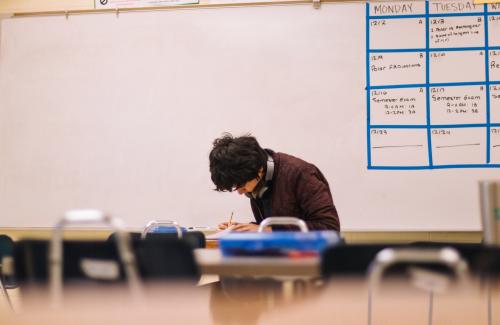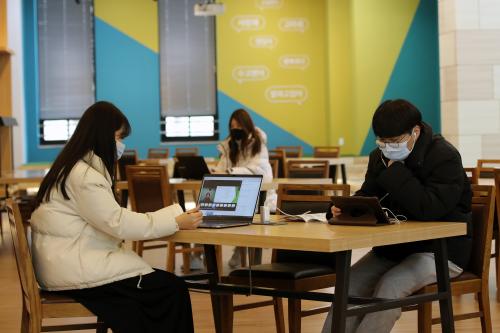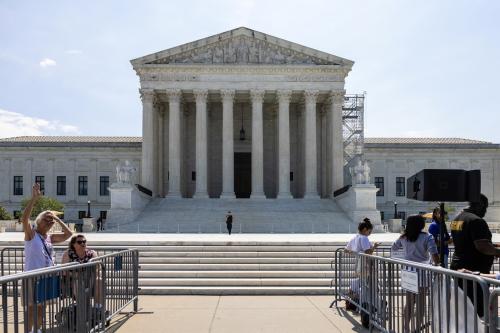Read the full report on college enrollment disparities and academic preparation here.
College graduates earn more, are healthier, and have more stable employment and marriages. Although young adults today are twice as likely to have a bachelor’s degree as they were fifty years ago, there are still sizable differences in enrollment by gender, race, and socioeconomic status. In our latest paper, we report new data on college enrollment gaps and explore how they relate to students’ high school academic preparation.
More than two-thirds (68%) of students enroll in college soon after high school; 44% of students attend a four-year college.[1] Figure 1 shows college enrollment rates by the highest institution level where students enrolled within 18 months of expected high school graduation. We focus on gaps across three categories: socioeconomic status, gender, and race.
 College enrollment rates vary greatly depending on the socioeconomic status of a student’s family. About 89% of students from well-off families go to college compared to 64% of students from middle-class families, and 51% of students from low-income families. [2] Socioeconomic gaps are especially large in four-year enrollment, with students in the top 40% significantly more likely to go to a four-year college than students in the bottom 60%.
College enrollment rates vary greatly depending on the socioeconomic status of a student’s family. About 89% of students from well-off families go to college compared to 64% of students from middle-class families, and 51% of students from low-income families. [2] Socioeconomic gaps are especially large in four-year enrollment, with students in the top 40% significantly more likely to go to a four-year college than students in the bottom 60%.
Girls are also more likely than boys to go to college: About 73% of girls and 64% of boys enroll in either a two-year or four-year college. This gender gap is driven by enrollment in four-year institutions. There is virtually no gap in the share of students who enroll in a two-year college, but 49% of girls enroll in a four-year college compared to 40% of boys.
Asian students are significantly more likely to enroll in college than any other race or ethnic group; 83% of Asian high school students enroll in college, compared with 72% of white, 63% of Hispanic, and 62% of Black students. Asian, Black, and white students are all more likely to enroll in a four-year than a two-year institution. Hispanic students, on the other hand, enroll in two-year institutions at a higher rate.
What role does academic preparation play?
High school students with high GPAs and test scores and who took more rigorous coursework are more likely to enroll in college. Academic preparation varies significantly by socioeconomic status, gender, and race. To what extent do gaps in academic preparation explain gaps in college enrollment?
In the report, we assess the role of group differences in academic preparation in explaining group differences in college enrollment. We find that, for students with similar academic preparation, college enrollment rate gaps are much smaller than the unconditional gaps shown in Figure 1. For example, Black, Hispanic, and Asian students with similar high school grades, test scores, and course-taking all go to college at about the same rate — a rate about five percentage points higher than white students with similar academic preparation by those measures. Similarly, boys and girls with the same high school grades go to college at about the same rate.
The most socioeconomically advantaged students are 38 percentage points more likely to go to college than the most disadvantaged students.
But the same is less true for differences in college enrollment by socioeconomic status. Holding constant high school performance, students from the most socioeconomically advantaged families (the top quintile) are 11 points more likely to go to college than students from the most disadvantaged families (the bottom quintile). Even though there are significant differences among students who had similar academic preparation depending on socioeconomic status, the differences are much smaller than the unconditional gaps by socioeconomic status shown in Figure 1: the most socioeconomically advantaged students are 38 percentage points more likely to go to college than the most disadvantaged students.
Our analysis cannot speak to the reasons for disparities in academic preparation, but it is important to note that academic preparation depends not only student actions, but also on factors not in their control, including the opportunities available to them. For example, a student might not take advanced coursework because it is not offered at their school, because they did not have strong instruction earlier in school, or because they had to work and had little time to study. Structural racism or discrimination in and out of school influences academic preparation, which in turn may explain disparities in college enrollment. Similarly, differences by gender may, in part, arise due to differences in how boys and girls are socialized.
Policymakers: address high school preparation gaps
Public discussions about inequality in access to college often center around admissions and cost. While these issues are important, our findings suggest that policymakers should also pay careful attention to disparities in academic preparation earlier in students’ educational careers, which are important determinants of college enrollment. Closing academic preparation gaps is particularly important to address gaps in college enrollment by race and gender. The same is true for socioeconomic status, though non-academic factors like cost or lack of information are also important given that large socioeconomic enrollment disparities remain among students with similar academic preparation. A fair educational and economic system would ensure that all students who want to attend college have the academic preparation necessary to do so.
Footnotes:
[1]: The HSLS of 2009 is a representative sample of US 9th graders in 2009, not necessarily the graduating class of 2013 or young adults in following years. We restrict our analytic sample on data availability. See the full report for details.
[2]: We use quintiles of socioeconomic status (SES) constructed by the NCES based on parent or guardians’ education, occupation, and income. Here, “well-off” refers to students in the top quintile of the SES distribution, “middle class” refers to students in the middle quintile, and “low-income” refers to students in the bottom quintile. See the full report for details.
The Brookings Institution is financed through the support of a diverse array of foundations, corporations, governments, individuals, as well as an endowment. A list of donors can be found in our annual reports published online here. The findings, interpretations, and conclusions in this report are solely those of its author(s) and are not influenced by any donation.







Commentary
College enrollment gaps: How academic preparation influences opportunity
January 23, 2023